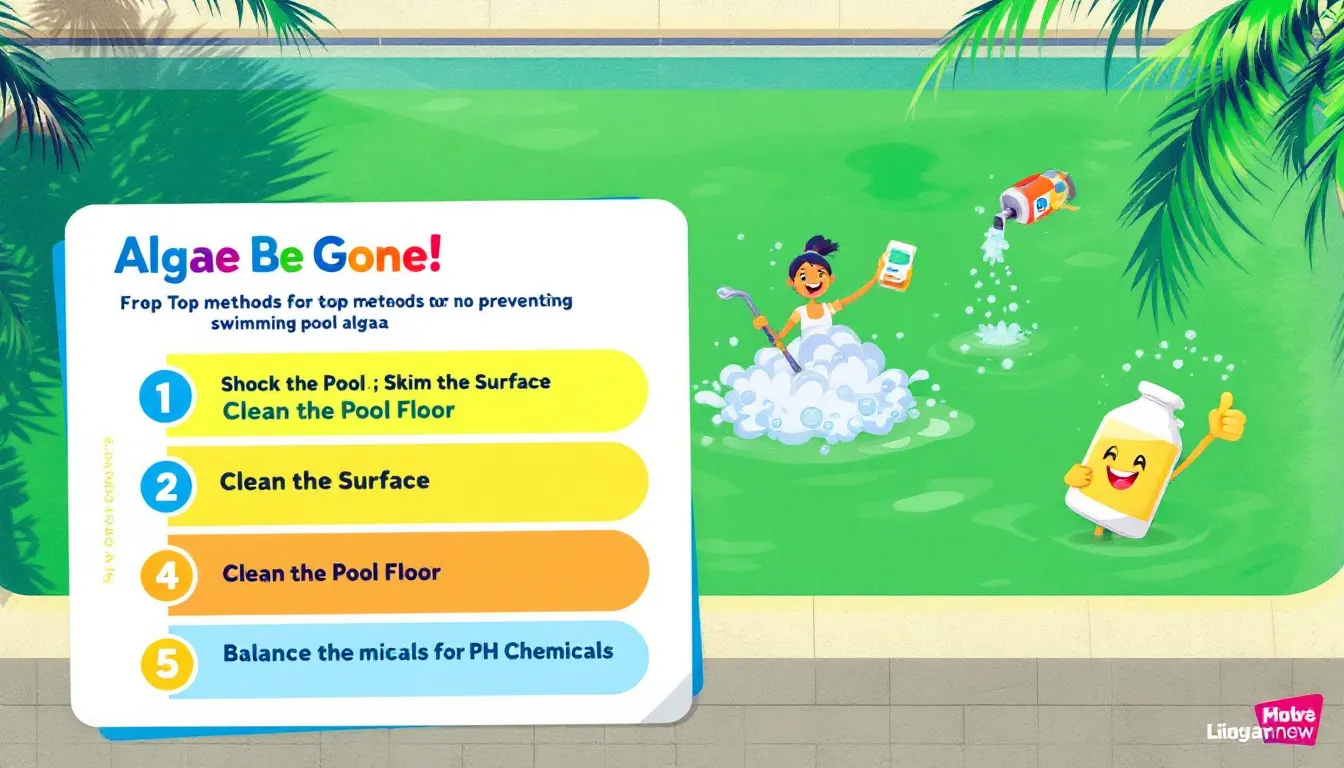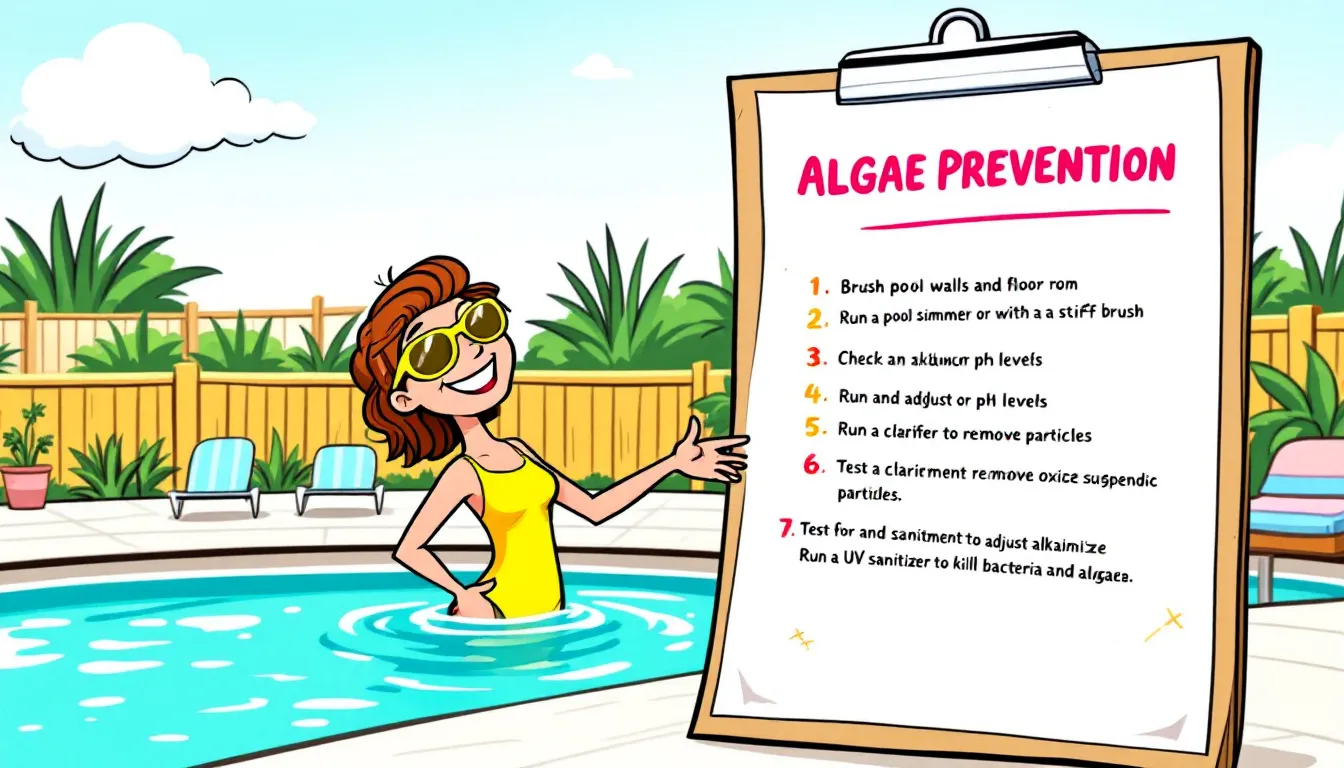
Top Tips: Best Methods for Preventing Swimming Pool Algae and How to Treat Algae Outbreaks and Blooms
Are you struggling with algae in your swimming pool? Knowing the best methods for preventing swimming pool algae and how to treat algae outbreaks and blooms is crucial for maintaining a clean and safe swimming environment. This article will guide you through effective prevention techniques, as well as practical steps to tackle and eliminate algae outbreaks.
Key Takeaways
Algae can significantly impact pool aesthetics and safety, flourishing in warm, stagnant environments and presenting various health risks.
Preventing algae requires regular maintenance, including balanced water chemistry, proper filtration, and strategic use of algaecides and phosphate removers.
Different types of algae necessitate tailored treatment approaches; effective management involves shock treatments, manual cleaning, and specialized chemical applications.
Understanding Pool Algae and Its Impact

Algae are tiny, plant-like organisms that thrive in warm, stagnant environments. They can appear in various colors, including green, yellow, black, and pink, and can be found either free-floating or stuck to pool surfaces. These unwelcome guests can transform your pristine swimming pool into an unsightly and potentially hazardous mess, especially during an algae bloom.
Not only do algae affect the aesthetic appeal of your pool, but they also pose health risks, such as skin infections and rashes. Algae can enter pools through wind, rain, or contaminated swimsuits and multiply rapidly under favorable conditions. Signs of an algae problem include discolored slime, cloudy water, and poor water quality, making regular maintenance crucial for prevention.
Types of Pool Algae
There are several types of pool algae that pool owners need to be aware of. Green algae, often the most common, thrive in areas with poor circulation and can quickly turn your pool into a green, murky mess. It’s relatively easy to treat but can be persistent if not addressed promptly.
Yellow algae, also known as mustard algae, are more resistant to chlorine and often grow in shaded areas with poor circulation. This type of algae requires more robust treatment methods and can be quite a challenge to control.
Black algae are particularly troublesome, embedding themselves into pool surfaces and forming tough, resistant colonies. They are usually found in concrete or gunite pools and require aggressive treatment to eradicate.
Pink algae, while less common, appear as a reddish slime around tile edges and skimmers. This type of algae can be difficult to remove and often requires specialized treatments to ensure it doesn’t return.
How Algae Affects Your Pool
Algae growth in your pool can lead to cloudy water, which decreases visibility and poses safety risks. When algae proliferate, the water becomes murky, making it difficult to see the bottom of the pool and increasing the risk of accidents.
Algae can also clog filters, complicating pool maintenance and reducing the efficiency of your filtration system. This can lead to increased maintenance costs and more frequent cleaning requirements.
Different types of algae can cause structural damage and discoloration to pool surfaces. For example, black algae can embed into plaster pools and cause significant damage if left untreated. Yellow and black algae can also stain and discolor the pool’s walls and floors.
Maintaining a clean pool free from algae is essential for water quality and safety. Poor maintenance practices, insufficient filtration, stagnant water, and unbalanced pH levels all contribute to algae growth. Regular maintenance, proper filtration, and balanced water chemistry are vital in preventing algae blooms.
Top Methods for Preventing Pool Algae

Preventing pool algae requires constant vigilance and a proactive maintenance plan. Effective algae control relies on both chemical treatments and proper pool maintenance tools. Utilizing advanced technologies can significantly enhance traditional algae prevention methods.
In the following sections, we’ll delve into maintaining balanced water chemistry, ensuring proper filtration and circulation, regular pool cleaning practices, and the strategic use of algaecides and phosphate removers. These methods combined will help you keep your pool algae-free.
Maintaining Balanced Water Chemistry
Balanced water chemistry is key to preventing algae growth and ensuring a safe swimming experience. Regularly testing your pool water helps maintain proper chemical levels, including pH and chlorine, making it hard for algae to thrive.
Super-chlorination, or shock treatment, involves raising chlorine levels to 10-20 ppm, which is highly effective in killing algae. Managing phosphate levels is also essential, as phosphates serve as a primary nutrient source for algae.
Ensuring Proper Filtration and Circulation
Proper filtration and circulation are key to preventing algae growth. Running the pool filter for at least 8 hours a day ensures that all pool water is filtered at least once per day, which is essential for effective algae prevention.
Regular cleaning of the filtration system helps avoid debris buildup that can attract algae. Good circulation prevents dead spots in the pool, which are ideal for algae growth. Advanced filtration media, like zeolite or diatomaceous earth (DE), can trap algae spores and enhance filtration efficiency.
Regular Pool Cleaning Practices
Regular pool cleaning prevents green algae growth. A consistent cleaning plan that includes brushing and skimming helps avoid algae buildup. A stiff pool brush and pool vacuums aid in removing algae and debris.
A pool skimmer is crucial for removing leaves and debris that can contribute to algae growth.
Using Algaecides and Phosphate Removers
Algaecides are formulated to control and prevent algae. Regular doses significantly reduce the chance to kill algae blooms.
Phosphate removers prevent algae growth by eliminating essential nutrients. Strategically using algaecides and phosphate removers maintains an algae-free pool.
Effective Treatment Methods for Algae Outbreaks

When algae outbreaks occur, prompt action is crucial to prevent severe problems in pool water quality and safety. Initial steps include balancing water chemistry, running the pool pump, and manual cleaning. An algae outbreak can lead to significant issues if not addressed quickly.
Specific methods for removing algae include shock treatments, manual cleaning, and utilizing products like Algae Attack Packs. Controlling black algae is particularly important due to its potential to cause structural damage.
Shock Treatments
Shock treatment involves an aggressive chlorine treatment using calcium hypochlorite, which effectively kills algae. Chlorine levels should reach 30 ppm during shock treatment for optimal effectiveness.
After shock treatment, running the filter for at least eight hours helps clear the water. Consulting a pool professional is recommended to ensure correct procedures are followed.
Manual Removal Techniques
Manual vacuuming is the most effective method. It helps to physically remove algae from the pool. Using a manual vacuum helps ensure targeted removal of algae from pool surfaces.
Balancing Chemical Levels Post-Treatment
Balanced water chemistry is crucial for a healthy pool and safe swimming, reducing the need for extra treatments like algaecides.
Special Considerations for Different Types of Algae

Different types of pool algae require unique treatment approaches. Effective management involves specialized methods for green, yellow, black, and pink algae.
Treating Green Algae
To remove green algae from a pool, manually vacuum and brush the surfaces. Additionally, balance the water chemistry and apply shock treatments.
If your pool has extreme green algae pollution, consider diluting the pool water by draining half and refilling.
Managing Yellow Algae (Mustard Algae)
Yellow algae, often referred to as mustard algae, can be quite challenging to remove. This is primarily due to their resistance to conventional chlorine treatments.
Removal requires robust treatment methods and consistent maintenance.
Eradicating Black Algae
Black algae are a resistant form of pool algae that typically grow in shady and out-of-the-way locations. The recommended approach includes multiple rounds of cleaning and maintaining a pH level of 7.2.
A steel-bristled pool brush is recommended for effective removal from plastered pools.
Controlling Pink Algae
The first step in treating pink algae is to shock the pool hard. Aggressive chlorine treatments alongside regular cleaning are essential for effectively treating pink algae.
After shocking the pool, a polymer algaecide labeled with the number 60 should be used.
Seasonal Maintenance Tips for Algae Prevention

Seasonal maintenance is crucial in preventing algae growth, as algae blooms can thrive in warm conditions without regular care. Adjust maintenance routines as seasons change; for example, increase cleaning frequency in summer and prepare for winter cover in colder months.
Winterizing Your Pool
Using a winter algaecide specifically formulated for low temperatures can help prevent algae during winter. Thoroughly cleaning and vacuuming the pool before closing it minimizes organic debris that can feed algae.
Spring Opening Procedures
Thorough cleaning of the pool is crucial to remove any debris or contaminants that can contribute to algae growth.
Advanced Algae Prevention Techniques
Innovative methods, such as UV systems and ozonators, enhance traditional maintenance practices and improve algae prevention. These technologies reduce reliance on harsh chemicals, making pool maintenance safer and more efficient.
UV Systems and Ozonators
UV systems and ozonators are advanced tools that can significantly improve pool maintenance and algae prevention. UV systems are effective at killing algae and preventing its reproduction by neutralizing algae spores and other microorganisms without adding chemicals. This results in a cleaner pool environment and reduces the need for chlorine by up to 60%.
Ozonators work by injecting ozone into the pool water, which oxidizes and destroys contaminants, including algae spores. Both UV systems and ozonators provide a more sustainable and efficient approach to maintaining a clean and algae-free pool.
Robotic Pool Cleaners
Robotic pool cleaners are another advanced tool that can help maintain a clean pool and prevent algae growth. Equipped with advanced sensors, these cleaners can navigate and clean the entire pool efficiently, ensuring thorough debris removal and maintaining water circulation.
Many robotic pool cleaners have programmable settings, allowing for customized cleaning schedules that can reduce the need for manual cleaning. By continuously monitoring and maintaining water circulation, robotic cleaners help prevent algae buildup and ensure a cleaner pool environment.
Essential Tools and Products for Algae Control
Having the right tools and products is essential for effective algae prevention and treatment in swimming pools. Using targeted products like algaecides not only effectively treats existing algae but also minimizes the likelihood of future pool algae prevention outbreaks.
Regular use of these tools ensures that your swimming pool remains clean and safe for users, including swimming pool owners and the pool surface.
Must-Have Pool Care Equipment
Essential equipment for preventing pool algae includes pool brushes, vacuums, and test kits. Using the right pool care products makes cleaning easier and more effective against algae, helping to maintain a clean and algae-free pool. Nylon bristle brushes are recommended for maintaining pool surfaces other than concrete.
Knowing how to use pool care equipment enhances the ability to eliminate algae. Regular maintenance with these tools, including brushing pool surfaces and vacuuming, is crucial for preventing algae growth and keeping your pool in top condition.
Recommended Chemicals
Specific chemicals are designed to address various types of algae, making them essential for effective algae control. Consistent chemical dosing is crucial for protecting the pool from algae and maintaining balanced water chemistry.
Chemicals like calcium hypochlorite for shock treatments and algaecides for ongoing maintenance ensure the pool remains algae-free and safe for swimming.
Summary
In summary, preventing and treating pool algae requires a combination of regular maintenance, proper water chemistry, and the use of advanced tools and products. Understanding the different types of algae and their impacts on your pool is the first step in effective algae control.
By maintaining balanced water chemistry, ensuring proper filtration and circulation, and using algaecides and phosphate removers, you can significantly reduce the likelihood of algae outbreaks. Advanced technologies like UV systems, ozonators, and robotic pool cleaners further enhance traditional maintenance practices and improve overall pool health.
Taking proactive steps to prevent algae growth and promptly addressing any outbreaks that occur will help you maintain a clean, safe, and enjoyable swimming pool environment. Dive into a crystal-clear pool and enjoy worry-free swimming all season long!
Frequently Asked Questions
What are the most common types of pool algae?
The most common types of pool algae include green algae, yellow algae (mustard algae), black algae, and pink algae, each requiring tailored treatment methods for effective removal. Addressing these specific types promptly is essential for maintaining a clean and healthy pool.
How can I prevent algae growth in my pool?
To effectively prevent algae growth in your pool, maintain balanced water chemistry, ensure proper filtration and circulation, regularly clean the pool, and consider using algaecides and phosphate removers. Taking these steps will help keep your pool clear and enjoyable.
What should I do if I have a severe algae outbreak in my pool?
To effectively address a severe algae outbreak in your pool, administer a shock treatment with high levels of chlorine and manually remove the algae through vacuuming. Subsequently, ensure you rebalance the chemical levels to prevent future outbreaks.
Are there any advanced tools that can help prevent algae in my pool?
Advanced tools such as UV systems, ozonators, and robotic pool cleaners can effectively prevent algae in your pool by improving water circulation and reducing reliance on harsh chemicals. Investing in these technologies will help maintain optimal water quality and cleanliness.
What chemicals are recommended for algae prevention and treatment?
For effective algae prevention and treatment, calcium hypochlorite is recommended for shock treatments, while algaecides and phosphate removers help with ongoing maintenance and nutrient control.

